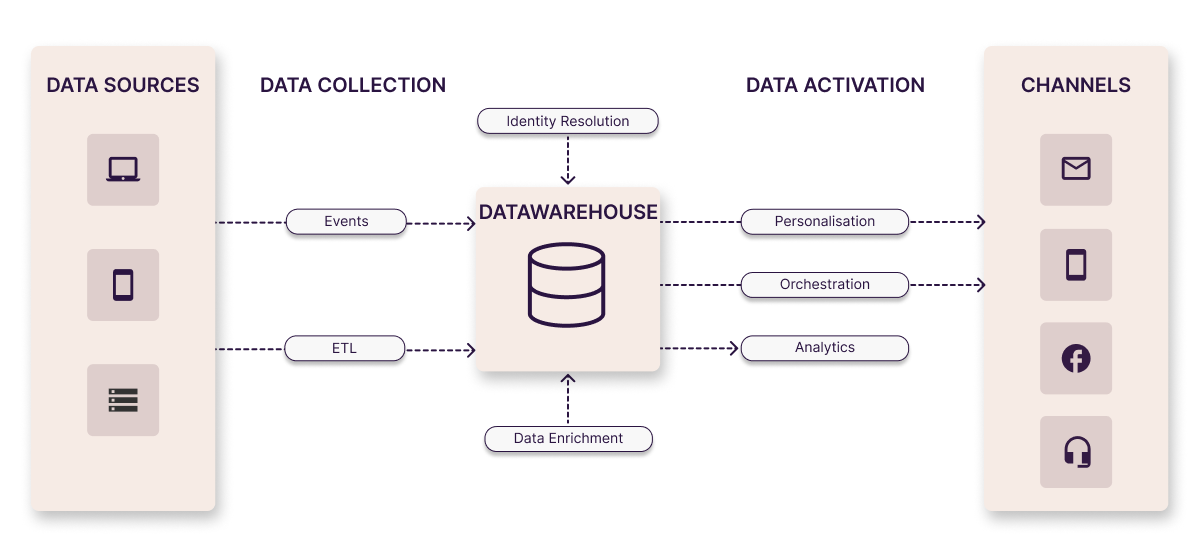Personalisation has become one of the most powerful tools in digital marketing. It’s about creating unique, relevant experiences for customers, which ultimately drives engagement and loyalty. But to do this successfully, businesses need a deep understanding of their customers — what they want, how they behave, and when they interact.
Historically, organisations have turned to Customer Data Platforms (CDPs) to centralise and manage their customer data. Traditional CDPs collect, organise, and store vast amounts of data, making it easier for marketers to access and use it in campaigns. However, these systems have limitations. They can be expensive, inflexible, and may fail to deliver a solid return on investment (ROI) due to their rigid architectures.
This is where composable CDPs come into play. These modular, flexible platforms offer a more tailored approach to customer data management, providing businesses with the ability to integrate seamlessly with their existing infrastructure and adopt the right tools for their specific needs. Let’s dive deeper into what composable CDPs are, how they work, and why they’re becoming the go-to choice for businesses seeking flexibility in their data operations.
What is a Composable CDP?
A composable CDP is a modular, customisable solution that uses your existing data infrastructure to collect, model, and activate customer data. Unlike traditional, monolithic CDPs, which operate as standalone platforms, composable CDPs integrate directly with a business’s existing systems such as its data warehouse allowing for better data consistency and reduced complexity.
The main advantage of a composable CDP lies in its architecture, which allows businesses to select and integrate best-of-breed components that work with their unique needs. Instead of forcing companies into a one-size-fits-all system, composable CDPs let businesses build their customer data platform piece by piece, choosing only the services they need. This can save time and money, but it can also enhance data security, as businesses don’t need to duplicate data or invest in additional storage infrastructure.
How Do Composable CDPs Work?
The architecture of a composable CDP can be thought of as an intermediary layer between your data warehouse and your operational systems. Rather than storing customer data independently, a composable CDP leverages the data already housed in your existing data warehouse, centralising it and making it accessible for use across various business tools.
Core Components of a Composable CDP
A composable CDP operates by integrating various components, each contributing to the effective management and activation of customer data. These components work together to ensure that the platform can gather, process, and utilise customer data across your business tools. Here’s a breakdown of the key components in a composable CDP:
1) Data collection and aggregation
This component is responsible for gathering customer data from diverse sources, such as websites, mobile apps, offline touchpoints, social media platforms, and third-party systems. Data can be collected in real-time or through batch processing, depending on the needs of the business.
2) Data unification and identity resolution
Once the data is collected, it needs to be unified into a comprehensive
customer profile. This process involves using unique identifiers, such as customer ID or email address, to link disparate data points together. The result is a single customer view that reflects the full scope of customer interactions, preferences, and behaviours. This unified view is stored within your data warehouse or another centralised system, which ensures data consistency and accuracy.
3) Data enrichment
Data enrichment adds additional insights to the customer profiles, enhancing the depth of information available. This can include third-party data, predictive models, or advanced attributes like customer lifetime value (CLV), churn likelihood, or next-best-action recommendations. By combining internal data with external data sources or using machine learning algorithms, businesses can create more detailed and actionable customer profiles.
4) Segmentation and personalisation
Once profiles have been enriched and attributes have been created, the next step is to segment customers based on shared characteristics or behaviours. This segmentation enables businesses to target specific groups with tailored content, messaging, and offers. Advanced audience segmentation techniques, such as cluster analysis or predictive modelling, can be employed to ensure that marketing efforts are relevant and timely.
5) Data activation
Data activation is the process of delivering the unified and enriched customer data to various downstream business systems, whether that’s for marketing automation, CRM, customer service, or advertising. This ensures that all departments have access to the most up-to-date and consistent customer data. Reverse ETL processes, such as those used by Fivetran or Hightouch, facilitate the flow of data from the data warehouse into operational systems, enabling real-time customer interactions across channels.
6) Analytics and reporting
A composable CDP provides access to powerful analytics tools that allow businesses to analyse and optimise customer interactions. By visualising key metrics and leveraging advanced data science techniques, businesses can understand customer behaviour, track campaign performance, and refine strategies. The insights gained from these analyses can be fed back into the system to improve segmentation, personalisation, and future customer experiences.

Why Are Composable CDPs Becoming More Popular?
Composable CDPs have several key benefits over traditional, monolithic systems. Let’s explore why they’re gaining traction in the marketplace.
1) Flexibility and cost effectiveness
Composable CDPs are significantly more flexible than traditional systems, as businesses can choose only the tools they need. This modular approach allows companies to avoid paying for unnecessary features, reducing overall costs. Additionally, since composable CDPs integrate with existing data infrastructure, businesses can avoid costly storage or data management solutions.
2) Time to value
Traditional CDPs often take months to implement, requiring businesses to adapt their processes to fit the platform’s rigid structure. Composable CDPs, on the other hand, are quicker to set up. The first use cases can be operational within a single day, providing businesses with a much faster return on investment (ROI).
3) Scalability
As your business grows, so can your composable CDP. You can add new components, integrations, or capabilities as needed, without having to overhaul your entire data system. This scalability is crucial for organisations that need to adapt to changing customer needs or business goals.
4) Data security and compliance
Composable CDPs offer enhanced security by leveraging existing data layers in your data warehouse, minimising the risk of duplication or data breaches. They also improve data compliance by allowing businesses to maintain better control over their customer data. This is particularly important for organisations that need to comply with strict regulations such as GDPR or CCPA.
5) Flexibility in data handling and unification
Composable CDPs move away from rigid data models, offering businesses more control over how their data is handled. Organisations can model data in a way that best fits their needs, creating more granular and detailed customer profiles. This flexibility allows businesses to tackle complex data challenges, such as integrating offline data or using predictive analytics for marketing.
6) Improved customer identity resolution
Traditional CDPs are often limited to clickstream data and may not capture the full complexity of a customer’s journey. Composable CDPs, on the other hand, allow businesses to integrate offline data, predictive models, and other unique customer attributes, leading to a richer understanding of customer behaviour.
Drawbacks of composable CDPs
While composable CDPs offer a range of benefits, they also come with certain drawbacks that businesses should consider before adopting this approach.
Here are some of the key challenges:
1) Complexity of Integration
One of the main drawbacks of a composable CDP is the complexity involved in integrating various components. Unlike traditional, all-in-one CDPs, a composable CDP requires businesses to select, configure, and integrate multiple tools or services. This can lead to integration challenges, particularly for organisations with complex tech stacks. Businesses need to ensure that all the different components (such as data integration, segmentation, and activation tools) work seamlessly together, which can require significant technical expertise.
2) Ongoing Maintenance and Management
Since composable CDPs rely on multiple third-party services and tools, managing and maintaining these integrations can be resource-intensive. Any updates, changes, or new releases from individual vendors may require manual adjustments or reconfigurations. This means that businesses must be prepared for continuous oversight to ensure that their data platform remains optimised and functional. This can be especially challenging for organisations that do not have dedicated technical resources.
3) Increased Vendor Management
Composable CDPs involve multiple vendors for different components, managing these vendor relationships can be more time-consuming than dealing with a single, integrated platform. Each vendor has its own service level agreements (SLAs), support protocols, and pricing structures, which can create challenges in terms of coordination, troubleshooting, and contract management. Additionally, businesses may face difficulties if a particular vendor’s product does not meet expectations or if they need to switch vendors for a particular component.
4) Higher Technical Expertise Requirements
Composable CDPs often require a higher level of technical expertise than traditional CDPs. Organisations need to have skilled teams to manage the integration, setup, and ongoing management of the platform. This can be a challenge for businesses that lack the necessary in-house technical expertise or resources. For smaller organisations or those with limited IT resources, the complexity and demand for technical skill might outweigh the benefits of composable CDPs.
Conclusion
Composable CDPs such as Hightouch and DinMo can offer a level of flexibility, scalability, and cost efficiency that traditional, monolithic CDPs can’t match. By integrating seamlessly with existing systems, and particularly the existing data warehouse, they can help organisations activate customer data faster and more cheaply.
However, it’s important to note that the composable CDP isn’t for everyone, and a level of technical maturity and expertise is necessary to get the most out of this approach. For businesses seeking to modernise their data infrastructure and take full advantage of their existing stack and skillsets, a composable CDP can be a great solution, but in order to do that, they must weigh up the complexity of integration and vendor management, whilst ensuring that they select the right tools and components for their needs.
How Peak Interval can help
At Peak Interval, we can help you unlock the full potential of your marketing and data technology stack. Whether you’re looking to integrate new tools, optimise your existing systems, or develop a tailored customer engagement strategy, our team of experts will guide you every step of the way.
From selecting the right platforms to ensuring seamless data integration and effective product development, we help you make the most of your technology investments. Get in touch today to explore how we can help you achieve your business objectives with a customised approach to your MarTech needs.
